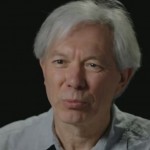Durrington Walls
In parallel with Darvill and Wainwright’s work, another major project was launched that would add weight to the idea that Stonehenge was in fact a place of the ancestors. This project focuses not on Stonehenge itself, but on the ceremonial landscape that surrounds it. In 2011, the archaeologist and broadcaster Neil Oliver investigated its findings, concentrating on the settlement of Durrington Walls, which lies some two miles from the monument itself.
Neil Oliver
Neil Oliver “Stonehenge is not alone. Nearby, this field contains all that remains of an ancient site of winter gathering.
Have a look at these. Animal bones and teeth. Just a sample, really of the thousands of animal remains found scattered all across the site. These are pig bones. Piglets are, unusually, born in the springtime, and the vast majority of the pig remains at Durrington Walls show that the adult animals were slaughtered at around nine months. That’s in midwinter. Also, the teeth reveal that the animals had been specifically fattened up prior to the feasting and we can tell this because the teeth are rotten.
What we have here isn’t just casual feasting. This is one final commemoration. It’s one big celebration of life before the ancestors commenced their journey to Stonehenge and the land of the dead.
It’s thought that each winter, people would come here from hundreds of miles around to commemorate the lives of their ancestors… and to ensure the souls of the recently dead reached the safety of the afterlife at Stonehenge itself.
The coldness of the stones, the open landscape – it’s not hard to believe that this place is somewhere that belongs to the dead.”
This idea that Stonehenge was built as a shrine to the dead will continue to be refined as more evidence is collected. But, it’s not the end of the story. And it takes its place alongside all of the other theories, none of which can yet be discounted.
Our greatest ancient monument remains as enigmatic as ever.
Stonehenge – The Epilogue
Professor Timothy Darvill “Stonehenge stands at the middle of a great archaeological problem, the problem of understanding what was going on during the fourth and third and second millenia BC in southern Britain, and Stonehenge not so much holds the key bit it provides the pivot on which those understandings can be built.”

Mike Pitts “When you look at the attempts people have made over the centuries to understand Stonehenge, you can always see that those ideas come from the times in which those thinkers were living, so in a century’s time, if we’re still here, people will look back on 21st-century archaeology and say, ‘Well, you know, the ideas that they came up with, of course, they came from their own societies. Tey have nothing to do with Stonehenge, but we have the abswer.’ And, that’s always going to continue.”
Professor Mike Parker Pearson “In some ways, the mystery of Stonehenge will not be solved, but every theory gets us that little bit closer towards it. We’ll never know the names of the people who put it up, for example, but we’ll know an awful lot about what their lives were like and their motivations for building such an extraordinary edifice.”
Over the centuries, our understanding of Stonehenge has been in constant flux, and from the antiquarians of the 18th century through to the archaeologists of today, every generation views this iconic monument through their own particular prism.
But in the past century, many of the myths have been exploded through the tireless efforts of archaeologists. Thanks to their work, we now know when the monument was built and how it evolved over time.
Over the 70 years that the BBC has been following the Stonehenge story, this iconic structure has been portrayed as a myriad of different things – an astronomical calculator, a temple of healing and as evidence that the ancient Greeks influence our ancestors.
But despite all the competing theories, innovative experiments and new discoveries, Stonehenge still holds on to some of its most precious secrets. And in the end, perhaps it’s that enduring mystery which keeps Stonehenge alive in our collective imaginations.
